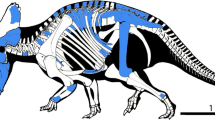Abstract
Bravoceratops polyphemus gen. et sp. nov. is a large chasmosaurine ceratopsid from the lowermost part of the Javelina Formation (early Maastrichtian) of Big Bend National Park, TX, USA. B. polyphemus has a distinctive narrow snout, a long fenestrate frill, and a fan-shaped median parietal bar with a midline epiparietal on its posterior margin, as well as a symmetrical depression on its dorsal surface at the nexus of the parietal rami. This depression is interpreted to be the attachment point for a second midline epiparietal. This parietal morphology is distinct from that exhibited by Anchiceratops or Pentaceratops. The posterior midline epiparietal in B. polyphemus and its bifurcated quadratojugal–squamosal joint are features shared with the most derived chasmosaurines, Torosaurus and Triceratops. The combination of primitive and derived traits exhibited by B. polyphemus, and its stratigraphic position, is compatible with the gradual transition from basal, to intermediate, to derived chasmosaurines observed throughout the western interior of North America, and with phylogenetic analysis, which suggests that Bravoceratops may be closely related to Coahuilaceratops.










Similar content being viewed by others
References
Anderson JS (1999) Occipital condyle in the ceratopsian dinosaur Triceratops with comments on body size variation. Contrib Mus Paleontol Univ Mich 30:215–231
Brown B (1914) Anchiceratops, a new genus of horned dinosaurs from the Edmonton Cretaceous of Alberta with a discussion of the origin of the ceratopsian crest and the brain casts of Anchiceratops and Trachodon. Bull Am Mus Nat Hist 33:539–548
Currie PJ, Langston W Jr, Tanke DH (2008) A new species of Pachyrhinosaurus (Dinosauria, Ceratopsidae) from the Upper Cretaceous of Alberta, Canada. a new horned dinosaur from an Upper Cretaceous bone bed in Alberta. NRC Research Press, Ottawa, pp 1–108
Dodson P, Forster CA, Sampson SD (2004) Ceratopsidae. In: Weishampel DB, Dodson P, Osmólska H (eds) The Dinosauria, 2nd edn. University of California Press, Berkeley, pp 494–513
Farke AA (2006) Morphology and ontogeny of the cornual sinuses in chasmosaurine dinosaurs (Ornithischia: Ceratopsidae). J Paleontol 80:780–785
Farke AA (2007) Cranial osteology and phylogenetic relationships of the chasmosaurine ceratopsid Torosaurus latus. In: Carpenter K (ed) Horns and beaks: Ceratopsian and Ornithopod dinosaurs. Indiana University Press, Bloomington, pp 235–257
Farke AA (2010) Evolution, homology, and function of the supracranial sinuses in ceratopsian dinosaurs. J Vertebr Paleontol 30:1486–1500
Farke AA (2011) Anatomy and taxonomic status of the chasmosaurine ceratopsid Nedoceratops hatcheri from the Upper Cretaceous Lance Formation of Wyoming, USA. PLoS One 6(1):e16196. doi:10.1371/journal.pone.0016196
Farke AA, Williamson TE (2006) A ceratopsid dinosaur parietal from New Mexico and its implications for ceratopsid biogeography and systematic. J Vertebr Paleontol 26:1018–1020
Gilmore CW (1919) A new restoration of Triceratops, with notes on the osteology of the genus. U. S. Natl Mus Proc 55:97–112
Godfrey SJ, Holmes R (1995) Cranial morphology and systematics of Chasmosaurus (Dinosauria: Ceratopsidae) from the Upper Cretaceous of western Canada. J Vertebr Paleontol 15:726–742
Hatcher JB, Marsh OC, Lull RS (1907) The Ceratopsia. Monogr US Geol Surv 49:1–300
Holmes RB, Forster CA, Ryan MJ, Shepherd KM (2001) A new species of Chasmosaurus (Dinosauria: Ceratopsia) from the Dinosaur Park Formation of southern Alberta. Can J Earth Sci 38:1423–1428
Horner JR, Goodwin MB (2006) Major cranial changes during Triceratops ontogeny. Proc R Soc B 273:2757–2761
Hunt RK, Lehman TM (2008) Attributes of the ceratopsian dinosaur Torosaurus, and new material from the Javelina Formation (Maastrichtian) of Texas. J Paleontol 82:1127–1138
Lambe LM (1915) On Eoceratops canadensis, gen. nov., with remarks on other genera of Cretaceous horned dinosaurs. Bull Can Geol Surv, Geol Series 24, 49 pp
Lawson DA (1976) Tyrannosaurus and Torosaurus, Maastrichtian dinosaurs from TransPecos Texas. J Paleontol 50:158–164
Lehman TM (1985) Sedimentology, stratigraphy, and paleontology of Upper Cretaceous (Campanian- Maastrichtian) sedimentary rocks in Trans-Pecos Texas. Dissertation, University of Texas at Austin
Lehman TM (1989) Chasmosaurus mariscalensis, sp. nov., a new ceratopsian dinosaur from Texas. J Vertebr Paleontol 9:137–162
Lehman TM (1993) New data on the ceratopsian dinosaur Pentaceratops sternbergi Osborn from New Mexico. J Paleontol 67:279–288
Lehman TM (1996) A horned dinosaur from the El Picacho Formation of West Texas, and review of ceratopsian dinosaurs from the American Southwest. J Paleontol 70:494–508
Lehman TM (1998) A gigantic skull and skeleton of the horned dinosaur Pentaceratops sternbergi from New Mexico. J Paleontol 72:894–906
Lehman TM (2001) Late Cretaceous Dinosaur Provinciality. In: Tanke D, Carpenter K (eds) Mesozoic vertebrate life. Indiana University Press, Bloomington, pp 310–328
Lehman TM, Busbey AB (2007) Big Bend field trip guidebook. Soc Vertebr Paleontol 67th Annual Meeting, 69 pp
Lehman TM, McDowell FW, Connelly JN (2006) First isotopic (U–Pb) age for the Late Cretaceous Alamosaurus vertebrate fauna of west Texas, and its significance as a link between two faunal provinces. J Vertebr Paleontol 26:922–928
Loewen MA, Sampson SD, Lund EK, Farke AA, Aguillón-Martínez MC, de Leon CA, Rodríguez-de la Rosa RA, Getty MA, Eberth DA (2010) Horned Dinosaurs (Ornithischia: Ceratopsidae) from the Upper Cretaceous (Campanian) Cerro del Pueblo Formation, Coahuila, Mexico. In: Ryan MJ, Chinnery-Allgeier BJ, Eberth DA (eds) New perspectives on horned dinosaurs: The Royal Tyrrell Museum Ceratopsian Symposium. Indiana University Press, Bloomington, pp 99–116
Longrich N (2010) Mojoceratops perifania, a new chasmosaurine ceratopsid from the late Campanian of western Canada. J Paleont 84:681–694
Longrich NR (2011) Titanoceratops ouranos, a giant horned dinosaur from the late Campanian of New Mexico. Cretac Res 32:264–276
Lull RS (1933) A revision of the Ceratopsia. Mem Peabody Mus Nat Hist 3:1–175
Maddison WP, Maddison DR (2011) Mesquite: a modular system for evolutionary analysis. Version 2.75. http://mesquiteproject.org
Maidment SCR, Barrett PM (2011) A new specimen of Chasmosaurus belli (Ornithischia: Ceratopsidae), a revision of the genus, and the utility of postcrania in the taxonomy and systematics of ceratopsid dinosaurs. Zootaxa 2963:1–47
Mallon JC, Holmes R, Eberth DA, Ryan MJ, Anderson JS (2011) Variation in the skull of Anchiceratops (Dinosauria, Ceratopsidae) from the Horseshoe Canyon Formation (Upper Cretaceous) of Alberta. J Vertebr Paleontol 31(5):1047–1071
Marsh OC (1890) Additional characters of the Ceratopsidae with notice of new Cretaceous dinosaurs. Am J Sci 39:418–426 (Series 3)
Maxwell RA, Lonsdale JT, Hazzard RT, Wilson JA (1967) Geology of Big Bend National Park, Brewster County, Texas. University of Texas Bureau of Economic Geology Publication 6711, 320 pp
Ostrom JH, Wellnhofer P (1990) Triceratops: an example of flawed systematics. In: Carpenter K, Currie PJ (eds) Dinosaur systematics: perspectives and approaches. Cambridge University Press, Cambridge, pp 245–254
Parks WA (1925) Arrhinoceratops brachyops, a new genus and species of Ceratopsia from the Edmonton Formation of Alberta. Univ Tor Stud Geol Ser 19:1–15
Porras-Múzquiz HG, Lehman TM (2011) A ceratopsian horncore from the Olmos Formation (early Maastrichtian) near Múzquiz, Mexico. Rev Mex Cienc Geol 28:262–266
Sampson SD, Loewen MA, Farke AA, Roberts EM, Forster CA (2010) New horned dinosaurs from Utah provide evidence for intracontinental dinosaur endemism. PLoS One 5(9):e12292. doi:10.1371/journal.pone.0012292
Scanella JB, Horner JR (2011) 'Nedoceratops'; an example of a transitional morphology. PLoS One 6(12):e28705. doi:10.1371/journal.pone.0028705
Seeley HG (1888) The classification of the Dinosauria. Rept Brit Assoc Adv Sci 1887:698–699
Sullivan RM, Lucas SG (2010) A new chasmosaurine (Ceratopsidae, Dinosauria) from the Upper Cretaceous Ojo Alamo Formation (Naashoibito Member), San Juan Basin, New Mexico. In: Ryan MJ, Chinnery-Allgeier BJ, Eberth DA (eds) New perspectives on horned dinosaurs: The Royal Tyrrell Museum Ceratopsian Symposium. Indiana University Press, Bloomington, pp 169–180
Weishampel DB, Barrett PM, Coria RA, Loeuff JL, Xing X, Sahni A, Gomani EMP, Noto CR (2004) Dinosaur distribution. In: Weishampel DB, Dodson P, Osmólska H (eds) The Dinosauria, 2nd edn. University of California Press, Berkeley, pp 517–606
Wiman C (1930) Uber Ceratopsia aus der oberen Kreide in New Mexico. Nova Acta Regiae Societatis Scientarum Upsaliensis 7(2):1–19, Series 4
Acknowledgments
Don Corrick and Dave Larson of the Division of Science and Resource Management, Big Bend National Park were especially supportive throughout this project. National Park Service pilot Scott Taylor made initial location and subsequent aerial survey of the remote study area possible. Thomas Shiller is extended a special word of gratitude for his camaraderie in the field, leading us to the “promised land,” and exhibiting his unique style of locomotion for which “the hippiewalk” site that yielded the specimen described herein is named. We thank Lori Manship and students from the University of Texas of the Permain Basin for their help excavating portions of the specimen. We also appreciate J. Wick and E. Lehman for their patient indulgence of the authors’ paleontological endeavors. The photographs shown in this paper were originally color images taken with oblique lighting. They were then adjusted in Adobe© Photoshop Elements version 6.0 using grayscale and the artistic filter “poster edges” to enhance surface features and illustrate greater morphological detail. Although converted to grayscale, Fig. 7b was not otherwise altered. Illustrations are the work of the authors.
Conflict of interest
The authors declare that they have no conflict of interest.
Author information
Authors and Affiliations
Corresponding author
Additional information
Communicated by: Robert Reisz
Appendix
Appendix
Character state scores for Bravoceratops polyphemus using 148 characters given by Sampson et al. (2010) as modified, including an additional character (149) described by Mallon et al. (2011). Two additional characters (150 and 151) described in the text are also included.
?1???????? ???????0?? ??????111? ????111011 ?1???10?11 1?????1?2? ??1?10?01? ?01?11?201 1101111?10 ????10?23? ???1111??? ????????11 ?????????? ?????????? ????????11 1
The following changes were made to the modified Sampson et al. (2010) taxon-character matrix: C. belli 35(0), 66(0); P. sternbergi 37(1); A. brachyops 50(1); and T. latus 95(1).
Rights and permissions
About this article
Cite this article
Wick, S.L., Lehman, T.M. A new ceratopsian dinosaur from the Javelina Formation (Maastrichtian) of West Texas and implications for chasmosaurine phylogeny. Naturwissenschaften 100, 667–682 (2013). https://doi.org/10.1007/s00114-013-1063-0
Received:
Accepted:
Published:
Issue Date:
DOI: https://doi.org/10.1007/s00114-013-1063-0




